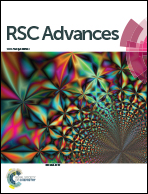Synthesis of sub-100 nm biocompatible superparamagnetic Fe3O4 colloidal nanocrystal clusters as contrast agents for magnetic resonance imaging†
Abstract
Synthesis of magnetic particles with superparamagnetism, high magnetization, excellent biocompatibility and small particle size is highly desirable for biomedical applications. Herein, we report that sub-100 nm biocompatible Fe3O4 nanocrystal clusters can be prepared via a solvothermal method by using water as a size-control agent and sodium citrate as a stabilizer. The resultant Fe3O4 particles have uniform spherical shape, superparamagnetic properties, high magnetization values, excellent colloidal stability and good biocompatibility. Notably, the particle size can be tuned over a range of 70–180 nm by changing the content of H2O in the system. Moreover, the T2-weighted magnetic resonance imaging (MRI) experiments show that 85 nm Fe3O4 particles have an ultra-high r2 relaxivity of 175.4 mM−1 s−1, suggesting a great potential as MRI probes. In addition, the labeling efficiency of mesenchymal stem cells with as-obtained Fe3O4 particles is much higher than that of commercial superparamagnetic iron oxide nanoparticles, which further indicates their promising in biomedicine.


 Please wait while we load your content...
Please wait while we load your content...